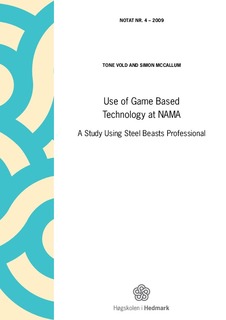Use of Game Based Technology at NAMA
Working paper
Permanent lenke
http://hdl.handle.net/11250/133482Utgivelsesdato
2009Metadata
Vis full innførselSamlinger
Sammendrag
Norsk: Målet med prosjektet er å teste effekten av å bruke Steel Beasts
Professional (SB) i taktisk trening på Krigsskolen. Aktivitetene i prosjektet var:
1. Forberede scenario
2. Bruke scenariet som en taktisk øvelse for kadettene – med en kontrollgruppe
som bruker kart og en testgruppe som bruker SB (dag 1)
3. Teste gruppenes terrengforståelse og deres løsninger ved å bruke Taktisk
Øving Uten Tropper (TØUT) (dag 2)
4. Vurdere bruken av tekstbasert rollespill som et formativt evalueringsverktøy
(dag 3)
Prosjektet har to mål: 1-3 tester effekten av broken av 3D visualisering og simulering
i forbindelse med planlegging og 1,2 og 4 tester bruken av rollespillsimulering som
et formativt verktøy for å evaluere læring.
Kadettene er delt i en kontrollgruppe og en testgruppe. Kontrollgruppen ble gitt et
scenario og fulgte standard prosedyre og papirbaserte kart, når de laget sin taktiske
plan. Kontrollgruppen fikk bruke SB og alle tilgjengelige views i dette
verktøyet/spillet.
I TØUT’en ble begge gruppene testet for terrengforståelse. Spørsmålene ble
designet for å vurdere hvordan kadettene svarte på spørsmålene og tiden det tok
dem å svare på spørsmålene. Hensikten var å finne ut om det var en signifikant
systematisk forskjell på måten kadettene utviklet en forståelse for terrenget i
scenariet.
En del av testing av rollespillsimulasjonen (RPS) var for å studere brukermedvirkning i
utvikling av scenariet. For å unngå at resultatene fra RPS skulle forveksles med resultatene fra SB, ble halvparten av kadettene som hadde brukt SB og halvparten av
de som hadde brukt papirbaserte kart satt til å gjennomføre en workshop for å
utvikle script for RPS. Etter workshoppen utviklet Wold og forskerteamet det
endelige scenariet for RPS’et. Deltakerne ble delt inn i fire roller: to SB–og to
kontrollgrupper. MS NetMeeting ble i RPS’en brukt for å kommunisere.
Rapporten viser resultatene fra denne studien. English: The aim of this project is to test the impact of using Steel Beasts Professional (SB) in
tactical training at the Norwegian Army Military Academy (NAMA). The activities in
this project were:
1. prepare the scenario
2. provide the scenario as a tactical exercise for the cadets with a control group
using maps and an test group using SB (day 1)
3. test the two groups understanding of the terrain and their solutions using a
Tactical Exercise Without Troops (TEWT) (day 2)
4. assess the use of text based role play as a formative assessment tool (day 3)
This project has two objectives: 1-3 test the effect of the use of 3D visualization and
simulation on planning, and 1, 2 & 4 test the use of role play simulation as a
formative assessment tool for learning.
The approach to testing the use of SB was to divide the cadets into a control group
and a test group. The control group was given the scenario and followed standard
procedure for developing a tactical plan using paper maps and manuals on operating
procedure. The test group was given the same task, but with access to SB, and
could use the tool in whichever way they chose.
In the TEWT the two groups were tested on their geographical awareness. The
questions were designed to assess how the cadets answered questions and the time
it took for them to respond to questions. The intent was to establish if there were
any significant systematic differences in the way in which the cadets developed an
understanding of the terrain in the scenario.
Part of the testing of the RPS was to investigate user participation in the
development of role play situation. To avoid confounding the RPS with the SB
results, half of the group using SB and half of the group doing the paper exercise
took part in a workshop developing the script for the RPS. After the workshop, Wold and the research team developed the final scenario for the RPS. The participants
were divided on four roles: two SB groups (one took part in workshop) and two
control groups (one took part in the workshop). MS NetMeeting was used as the
communication system for the RPS.
Serie
Notat04/2009
